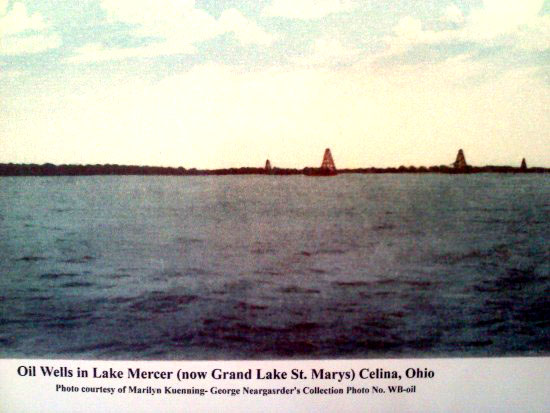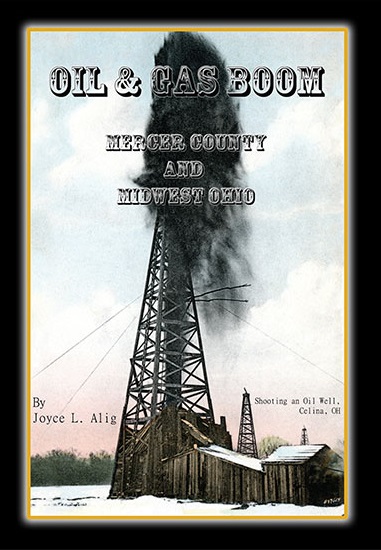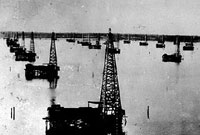Oil was produced from platforms on Grand Lake St. Marys as early as early as 1887.
As the turn of the century approached, oil producing Ohio wells drilled far out over a reservoir mark the beginning of America’s offshore petroleum industry, according to Mercer County historians.
America’s first offshore drilling once was generally acknowledged to be over Louisiana’s Caddo Lake in 1911 – until researchers in Mercer and Auglaize counties in Ohio said otherwise.
Oil patch sleuths pointed to Mercer County documents recording wells producing oil above the waters of Grand Lake St. Marys at least 20 years before drillers ventured over the waters of Caddo Lake above the giant Caddo-Pine Island field.

Oil wells on Grand Lake, Ohio, after heavy rains in 1887 caused a rise in the lake level. Photo from 2020 book, Oil & Gas Boom, Mercer County and midwestern Ohio, by Joyce Alig.
Work on the Ohio reservoir that would become Grand Lake St. Marys — about 60 miles north of Dayton — began in 1837 to support water levels of the Miami and Erie Canal. Eight years of construction (1,700 men earning 30 cents a day) took place near the towns of Celina and St. Marys.
By 1845 the reservoir covered 17,500 acres to a depth of no more than seven feet. It was the largest man-made body of water in the world at the time and successfully supported the vital commerce of the Miami and Erie Canal. Forty years later Ohio’s first oil boom began.
Independent producers in 1884 near Findlay discovered natural gas in a geologic formation known today as the Lima-Indiana trend. The formation would prove to stretch 260 miles across Ohio and Indiana. In coming years it would yield extraordinary quantities of natural gas and oil (an estimated 500 million barrels of oil from around 100,000 wells).
By the mid-1880s, exploration companies had followed the Lima-Indiana Trend southwest to the shores of Grand Lake St. Marys near the Indiana border. Local ventures, including Neeley-Clover Oil Company, Riley Oil Company, and Manhattan Oil Company, drilled successful oil wells to the reservoir’s shoreline, but going offshore presented a new set of challenges.
According to Joyce L. Alig, president of the Mercer County Historical Society, “the first oil well drilled in Celina, Ohio (on the west side of Grand Lake) was in June 1886 and in St. Marys, Ohio, (on the east side of Grand Lake) in July 1886. Citizens had homes around Grand Lake drilled oil wells in their back yards on the beach between their homes and Grand Lake.”
Major storms and rains in February 1887 resulted in the rise of the level of Grand Lake. “This rise resulted in the platforms of the oil wells along the beach, being covered with water,” historian Alig noted a century later. “The oil well platforms continued to be covered with water, i.e. the first offshore oil wells on the reservoir (Grand Lake) were in February 1887.”
Offshore wells and “Cribs”
Contemporary accounts of over-water drilling describe the practice of building 14 foot square “cribs” upon which traditional cable-tool rigs and their steam engines and boilers could be supported. Cribs had evolved as necessary engineering solutions to building bridges, dams, and other water structures.

Grand Lake St. Marys – hand-dug from 1837 to 1845 – originally was nine miles long by three miles wide. It supplied water to central Ohio’s Miami and Eric Canal until designated a “public recreation and pleasure resort” in 1915.
On Grand Lake St. Marys, oilmen built derricks atop cribs. New pipelines would carry the oil from these Ohio offshore wells to storage tanks hastily constructed on shore. The 1898 Auglaize County Atlas identified an abundance of oil wells surrounding the far eastern end of Grand Lake St. Marys and also shows wells built offshore.
The 1903 Ohio Geological Survey recorded, “By 1890 the productive territory had been pushed to the eastern border of the Grand reservoir, and a year later wells were being drilled in that body of water.”
The Ohio Department of Natural Resources (DNR) has noted that in 1891, “at the beginning of production in the water of Grand Lake St. Marys, wells were drilled within the canal reservoir mainly by small local companies…In less than ten years, more than 100 wells were drilled within the shallow waters of the lake.”
In 1915 the state of Ohio determined that with the canal no longer in use, Grand Lake St. Marys was repurposed as a public recreation and pleasure resort area, which it remains today. A modern DNR map still plots the locations of the historic of the Ohio offshore wells over the lake.
The Neely-Clover Oil Company was an early driller on the lake that completed many successful wells. In Wildcatting from Pennsylvania to Texas, author Harold Neely writes, “Part of the leases they had were out in the lake that was known as the Grand Reservoir of St. Marys, and these leases were secured from the state of Ohio. They drove pilings and set the rig up on platforms and drilled these wells, one to ten acres, and quite a bit of this state land was productive.”
Riley Oil Company drilled more than 100 oil wells in the reservoir, including the Riley-Mosher well, which began producing in 1886 and still produced 35 barrels a day as late as 1910. By then, however, the Ohio offshore oil boom was over.
In 1913 the New York Times reported the reservoir contained more than 100 oil wells, but exploration companies had moved on. Production on the waters of Grand Lake St. Marys lost its economic incentive when the astounding production from oilfields at Spindletop, Texas, drove the price of Ohio crude below 15 cents a barrel. The once plentiful derricks gradually disappeared into Ohio’s petroleum history.
Preserving Ohio Oil Patch History
Ohio petroleum historian Joyce L. Alig, president of the Mercer County Historical Society, has edited almost 30 publications, including Our Post Card Past; Grand Lake St. Marys Ohio. After years of research, in 2020 she published a carefully documented book focusing on midwestern Ohio’s oil and natural gas history, 1886 through the 1890s.

Joyce L. Alig’s 2020 book on late 19th century Ohio petroleum history includes many first hand accounts from newspapers.
Messenger Press of Carthagena published Alig’s 236-page Oil & Gas Boom, Mercer County and Midwest Ohio, which examines the offshore wells on Grand Lake St. Marys, along with other petroleum production in Mercer and Auglaize counties.
“I may not be a professional geologist, but I am an historian,” the author noted shortly after publication in an email to the American Oil & Gas Historical Society. “The mix of geology and history is just like taking one exciting vacation,” she added.
In addition to the historic Grand Lake St. Marys offshore wells, Alig’s book offers, “first hand accounts in the old newspapers about the oil and gas wells being drilled, and the names of the sites and villages and farms where the wells were drilled, plus the dates, in Mercer, Auglaize, Van Wert, Darke Counties, Ohio and Jay County, Indiana.”

Oil wells on Grand Lake, Ohio, after heavy rains in 1887. Photo courtesy Joyce Alig.
Alig noted it was important to include available late 19th century photos and clippings along with a detailed index that allows further research into local history and the stories of area citizens.

After the Ohio offshore wells, rigs appeared on Louisiana’s Caddo Lake, as seen in this circa 1911 photo.
In 2005, the Ohio oil historian provided much of the Ohio’s lake history research for “The First Over Water Drilling: The Lost History Of Ohio’s Grand Reservoir Oil Boom,” a peer-reviewed article by Judith Sneed of Mooringsport, Louisiana.
Sneed originally presented the article in Shreveport during a Petroleum History Symposium, hosted by the Petroleum History Institute of Oil City, Pennsylvania. Sneed’s abstract in the peer-reviewed Oil-History Journal notes:
In 1911 Gulf Oil Company’s Ferry Lake No.1 well was completed over the waters of Caddo Lake, Louisiana. It has long been touted as the location of the world’s first over water oil well. This accolade, however, is not correct. Stand alone oil wells produced commercial quantities of oil over a small lake in Ohio…How did we lose this bit of history?
Also see Offshore Petroleum History.
_______________________
Recommended Reading: Oil & Gas Boom, Mercer County and Midwest Ohio (2020);* Ohio Oil and Gas (2008); Where it All Began: The story of the people and places where the oil & gas industry began: West Virginia and southeastern Ohio (1994). Your Amazon purchase benefits the American Oil & Gas Historical Society. As an Amazon Associate, AOGHS earns a commission from qualifying purchases.
* Joyce L. Alig’s limited edition book is available from the Mercer County Historical Society for $45. Learn more at Lakefront Improvement Association.
_______________________
The American Oil & Gas Historical Society preserves U.S. petroleum history. Please become an AOGHS annual supporter and help maintain this energy education website and expand historical research. For more information, contact bawells@aoghs.org. © 2025 Bruce A. Wells. All rights reserved.
Citation Information – Article Title: “Ohio Offshore Wells.” Authors: B.A. and K.L. Wells. Website Name: American Oil & Gas Historical Society. URL: https://aoghs.org/offshore-history/ohio-offshore-wells. Last Updated: January 4, 2025. Original Published Date: January 13, 2011.

